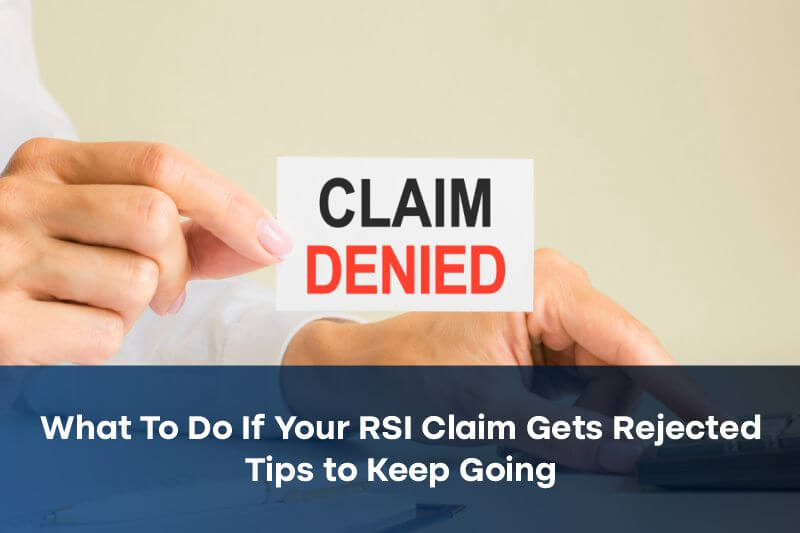Filing RSI claims (Repetitive Strain Injury claims) can feel like an uphill battle. You gather medical evidence, describe how the pain affects your life, and put your trust in the process—only to receive a rejection letter. It’s frustrating, disheartening, and in some cases, overwhelming. But a rejection doesn’t have to be the end of the road. With the right steps and persistence, you can strengthen your case and keep moving forward toward the compensation you deserve.
In this guide, we’ll break down why RSI claims are sometimes rejected, what you can do next, and practical strategies to keep your case alive. Along the way, we’ll share personal insights and examples that show how persistence often pays off.
Why RSI Claims Get Rejected
Understanding why claims are denied is the first step toward building a stronger case. Common reasons include:
- Lack of medical evidence: If the medical records don’t clearly link your injury to your work, insurers or employers may reject the claim.
- Insufficient workplace documentation: A claim often needs proof that your work conditions contributed to the RSI.
- Missed deadlines: Strict timelines apply, and missing them can lead to automatic rejection.
- Disputed liability: Sometimes, employers argue that your injury wasn’t caused by your job.
I once worked with someone whose claim was denied because their medical report simply stated “wrist pain” without explaining how repetitive typing caused it. Once their doctor provided a detailed occupational health report, the claim was reconsidered.
Rejections often highlight weak points in your case. Instead of treating them as a dead end, think of them as a guide for what to strengthen.
Don’t Panic: Rejections Are Common
Gather Stronger Medical Evidence
Medical documentation is the backbone of RSI claims. If your claim was rejected, this is often where to start:
- Request a detailed report: Ask your doctor or specialist to explain how your work activities led to the injury.
- Seek an occupational health assessment: These reports carry weight because they directly link job duties to injuries.
- Keep a pain diary: Documenting daily struggles—like struggling to grip objects or type—can illustrate how RSI affects your life.
For example, one claimant I knew kept a log showing how their wrist pain limited their ability to drive, cook, or even hold a pen. That diary became compelling evidence of the injury’s impact.
Strengthen Workplace Evidence
Even with medical proof, claims can fail if there’s no link to your workplace. To address this:
- Collect witness statements: Co-workers who’ve seen your struggles can support your case.
- Highlight repetitive tasks: Describe your daily duties in detail—typing for eight hours, lifting boxes, or operating machinery.
- Request ergonomic assessments: If your workplace has poor ergonomics, reports of this can reinforce your case.
Many employers resist acknowledging workplace responsibility, but clear documentation of your tasks makes it harder for them to deny the connection.
Consider Professional Legal Help
RSI claims can get complicated, especially after rejection. At this stage, getting professional legal support is often worth it. A solicitor experienced in personal injury or workplace claims can:
- Review your rejection letter and identify weaknesses
- Help gather stronger medical and workplace evidence
- Represent you in appeals or negotiations
I’ve seen cases where a simple legal letter outlining the evidence led to an employer settling the claim rather than risking court proceedings. Sometimes, the backing of an expert makes all the difference.
File an Appeal or Reapply
A rejection doesn’t close the door—it just means more work is needed. Depending on your situation, you can:
- Appeal the decision: This involves challenging the rejection directly, often with added evidence.
- Reapply: If timelines allow, submitting a new, stronger application may be the best route.
When appealing, carefully read the rejection letter. It usually states why your claim was denied, which helps you target the gaps in your evidence.
Stay Persistent and Patient
Conclusion: Keep Going, Your Claim Matters
A rejected claim is not the end. It’s an invitation to strengthen your evidence, seek a professional law firm’s help, and try again. With the right medical proof, workplace documentation, and persistence, many people succeed on their second or even third attempt.
If your RSI claim has been rejected, don’t lose heart. Take a step back, gather stronger evidence, and keep pushing forward. Your health and your rights matter too much to give up on.
Next step: If you’ve had an RSI claim rejected, speak to an expert solicitor or occupational health specialist today. The sooner you act, the stronger your chances of success.



